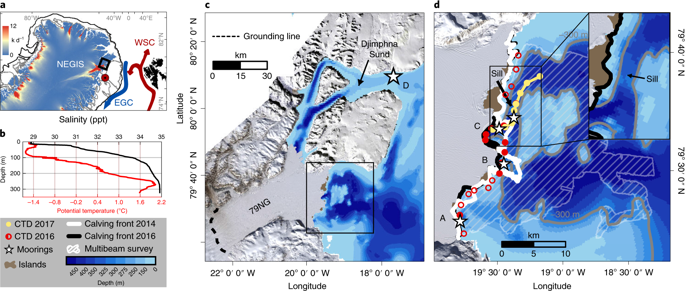Nature Geoscience ( IF 15.7 ) Pub Date : 2020-02-03 , DOI: 10.1038/s41561-019-0529-x Janin Schaffer , Torsten Kanzow , Wilken-Jon von Appen , Luisa von Albedyll , Jan Erik Arndt , David H. Roberts

|
Mass loss from the Greenland ice sheet has increased over the past two decades, currently accounting for 25% of global sea-level rise. This is due to increased surface melt driven by atmospheric warming and the retreat and acceleration of marine-terminating glaciers forced by oceanic heat transport. We use ship-based profiles, bathymetric data and moored time series from 2016 to 2017 of temperature, salinity and water velocity collected in front of the floating tongue of the 79 North Glacier in Northeast Greenland. These observations indicate that a year-round bottom-intensified inflow of warm Atlantic Water through a narrow channel is constrained by a sill. The associated heat transport leads to a mean melt rate of 10.4 ± 3.1 m yr–1 on the bottom of the floating glacier tongue. The interface height between warm Atlantic Water and colder overlying water above the sill controls the ocean heat transport’s temporal variability. Historical hydrographic data show that the interface height has risen over the past two decades, implying an increase in the basal melt rate. Additional temperature profiles at the neighbouring Zachariæ Isstrøm suggest that ocean heat transport here is similarly controlled by a near-glacier sill. We conclude that near-glacier, sill-controlled ocean heat transport plays a crucial role for glacier stability.
中文翻译:

测深法限制了格陵兰岛最大冰川舌头对海洋的热量供应
在过去的二十年中,格陵兰冰原的质量损失有所增加,目前占全球海平面上升的25%。这是由于大气变暖以及海洋热传输迫使海洋终止冰川退缩和加速而导致的表面融化增加。我们使用2016年至2017年的舰船剖面,测深数据和系泊时间序列,收集了东北格陵兰岛79北冰川浮舌前方收集的温度,盐度和水速。这些观察结果表明,全年不断增加的底部温水通过狭窄的渠道流入大西洋,受到门槛的限制。相关的热传递导致平均熔化速率为10.4±3.1 m yr –1在漂浮的冰川舌头的底部。窗台上方温暖的大西洋水和较冷的上覆水之间的界面高度控制着海洋热传输的时间变化。历史的水文数据表明,在过去的二十年中界面高度已经增加,这意味着基础融化速率会增加。邻近的ZachariæIsstrøm的其他温度曲线表明,这里的海洋热量传输同样受到近冰川基岩的控制。我们得出的结论是,接近冰川的,由基石控制的海洋热传输对于冰川的稳定性起着至关重要的作用。










































 京公网安备 11010802027423号
京公网安备 11010802027423号